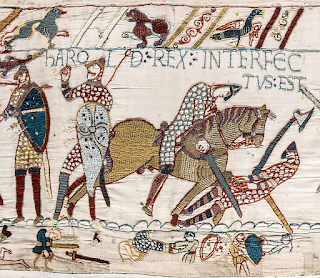Ancient Pictures as inspiration for Storyboarding.
As part of the M.A for Narrative Environments at Central St Martins we use storyboards as a technique for developing narrative projects. Tutors on the course collected examples. I looked at inspiration from ancient sources.
Bayeaux tapestry
Bayeaux tapestry
The tapestry moves through time and
space with a clear narrative. Different narrative layers are used.
Simple conventions make it easier to read – the English for example
have moustaches while the Normans have pudding basin hairstyles.
Text is limited for example to crucial identification of leading characters.
Places are not spelt out though can be identified by those who know
by context and form. The narrative structure is linear and has beautiful clarity. The top
and bottom strips allow additional information often decorative but
often individual stories or symbols.
The following shows a scrolling video of the Tapestry:
Charles Duke of Orleans in the Tower
This is a single image but time is
shown passing. This is indicated by the simple method of showing
Charles in distinctive clothes so you can recognise the multiple
occurrences of this person as time passes..
The duke is shown in prison in the
Tower writing – is he writing his poetry (this is the frontispiece
of his book of poetry) or is he writing a letter to his relatives
saying 'Oi! I've been here 20 years while you fail to raise my
ransom!' (he was imprisoned for 20 years after being taken prisoner
at the Battle of Agincourt while his family raised the enormous
ransom).
He is shown looking out of the window
for the ransom money to arrive; he is shown greeting the money; He is shown riding out of the Tower to
freedom; he is shown boating to freedom to a
boat to take him home
https://en.wikipedia.org/wiki/
https://en.wikipedia.org/wiki/
Siege of Lachish British Museum
This is an alabaster relief which provides an extended
portrait of a siege of a town in Palestine by King Senacherib of
Assyria. It is like a long camera pan across the battlefield
but time passes as you move from left to right seamlessly but you
also move geographically from the West to the East. So it doesn't
have frames but in a single image the story of the siege is told seamlessly,.
Here is a youtube illustration of the siege relief
Trajan's Column
Trajan's Column shows a vast
scrolling narrative of the invasion of Dacia by Trajan. It is full
of detail and is used by Archaeologists to understand Roman military
campaigns and methods of colonisation. The relief are quite subtle
often using different viewpoints to elucidate information and can be
used as a model of using images to tell a story.
But what makes it interesting is that
it would have been very difficult to read despite the fact that the
Romans built 2 libraries to the side of it with viewing platforms.
Trajan is depicted 58 times (in yellow above); his ashes were buried
in a vault on the ground level, and a statue of him on top. So the
public could never see all the detail and so the interpretation was that the primary purpose was to glorify the Emperor – the detail was
as much to impress as to be read by the public.
This is an interesting article on the
Column. http://www.nationalgeographic.
http://flavorwire.com/349534/




Comments